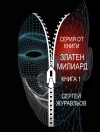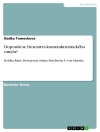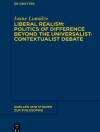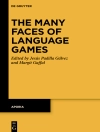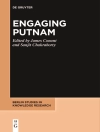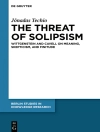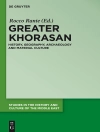This book, originally published in French, examines the philosophical debates on functions over the last forty years and proposes new ways of analysis. Pervasive throughout the life sciences, the concept of function has the air of an epistemological scandal: ascribing a function to a biological structure or process amounts to suggesting that it is explained by its effects. This book confronts the debates on function with the use of the notion in a wide range of disciplines, such as biology, psychology, and medicine. It also raises the question of whether this notion, which is as old in the history of technology as it is in the life sciences, has the same meaning in these two domains.
Tabella dei contenuti
Introduction to the English version*.- Original introduction.- PART 1 – CONCEPTUAL AND HISTORICAL PROBLEMS . Section 1. Origins of functional discourse in the life sciences Chapter 1 – Biological Function: A Brief Slice of History (James G. Lennox).- Chapter 2 – The Structure-Function Relationship in the Advent of Biology (François Duchesneau).- Chapter 3 – Tissues, Properties, Functions: The Term Function in French Biology in the Early 19th Century (Laurent Clauzade).- Chapter 4 – « Design », History of the Word and the Concept: Natural Sciences, History, Theology, Aesthetics (Daniel Becquemont).- Chapter 5 – Function and Purpose: Review of the “Written Symposium” (1976-1984) Organized by the Institut de la Méthode of the Ferdinand Gonseth Association (Pierre-Marie Pouget) *.- Section 2. Function, selection, adaptation Chapter 6 – How are Traits Typed for the Purpose of Ascribing Functions to Them? (Karen Neander).- Chapter 7 – Attribution of Functions and Levels of Organization in Biology (Jean Gayon).- Chapter 8 – Function and Adaptation: A Conceptual Demarcation, Instigated by Borderline Cases for Etiological Theory (Philippe Huneman).- Chapter 9 – Function, Adaptation, and Design in Biology (Gustavo Caponi)*.- Chapter 10 – Ecological Functions, External Teleology and Between-Species Beneficial Relations (or How Aristotle and Kant Can Help us Understand Functions in Ecology) (Antoine C. Dussault)*.- PART 2 – FUNCTIONS IN BIOLOGY . Section 3. Structures and functions in morphology and paleontology Chapter 11 – The Problem of Complex Causality at the Origin of the Structure-Function Relationship 1/ Generality, 2/ The Case Of Bone Tissue (Armand de Ricqlès and Jorge Cubo).- Chapter 12 – Structure, Function and Evolution of the Middle Ear of Extant and Extinct Vertebrates: Paleobiological and Phylogenetic Interpretations (Michel Laurin).- Section 4. Attributions of function in experimental biology Chapter 13 – The History of Integration: From Spencer to Sherrington and Later (Jean-Claude Dupont).- Chapter 14 – Assigning Functions to Individual Macromolecules: A Complex History that Reflects the Transformations of Biology (Michel Morange).- Chapter 15 – Function, Functioning, Multifunctionality: Genetics of Development and Evolution (Charles Galperin).- Chapter 16 – Does the Immune System have a Function? (Thomas Pradeu).- Section 5: Functions and the Origins of Life Chapter 17 – Functions in Chemistry (Aurore Dupin)*.- Chapter 18 – Heterotrophy vs. Autotrophy: Carbon Metabolism in the Debate on the Origins of Life in the Middle of the 20th Century (Stéphane Tirard).- Chapter 19 – What are Ribozymes for? Arguing for Function Pluralism (Christophe Malaterre).- Section 6. Functions in Psychology and Neuroscience Chapter 20 – Functionalist Psychologists From the School of Chicago and the Beginnings of Behaviorism (Françoise Parot).- Chapter 21 – Face Recognition and Functional Analysis (Denis Forest).- PART 3 – FUNCTION AND DYSFUNCTION IN MEDICINE AND IN TECHNOLOGY . Section 7. Function and Malfunction Chapter 22 – Dys-, Mal- and Non-: the Other Side of Functionality (Ulrich Krohs).- Chapter 23 – Functional Reasoning in Psychiatry (Arnaud Plagnol).- Section 8. The Same Functional Reasoning in Engineering and Biology? Chapter 24 – The Idea of Function in Biology and Robotics as Reflected in the “Robo Coq” Project (Anick Abourachid and Vincent Hugel).- Chapter 25 – Theories of Technical Functions: Sophisticated Combinations of Three Archetypes (Wybo Houkes and Pieter E. Vermaas).- Chapter 26 – What a Functional Explanation Explains: the Case of Bio-Artifacts (Françoise Longy).- Chapter 27 – Technical Function, Use and Functioning in Simondon’s Ontogenetic Thought (Jean-Hugues Barthélémy)*
Circa l’autore
Jean Gayon
Jean Gayon’s works have developed in two directions: philosophy and the history of life sciences. His historical work focuses mainly on the 19th and 20th centuries: population biology and biometrics, the theory of evolution, genetics. His philosophical work has itself developed in the following directions: (1) The conceptual clarification of a number of issues commonly addressed by what has been called since the 1970s the philosophy of biology; for example: the concept of species, the structure of the theory of evolution, units of selection, chance. (2) The analysis of some of the typical figures of ‘biological philosophies’ of the 19th and 20th centuries (Bernard, Nietzsche, Pearson, Canguilhem, Dagognet, Sober, Grene, etc.). (3) An involvement in some ethical-political issues related to life and health sciences: genetic improvement of humanity, eugenics, human races.
In addition to this work on the history and philosophy of biology, Jean Gayonalso has contributions on issues relating to the general philosophy of science and its history.
Armand de Ricqlès
Armand de Ricqlès is a French paleobiologist best known for his work in bone histology and its implications for the growth and thermometabolism of dinosaurs. He worked in the University of Paris (and later Université paris VII) from 1961 till 1995, when he was nominated to a chair of Historical and Evolutionary Biology at the Collège de France. He officially retired in 2010, but he continues publishing.
Armand de Ricqlès initially worked on the functional significance of extant bone histodiversity, and applied this newly gained knowledge in paleobiological inferences. He has collaborated with several histologists and paleontologists, including Melvin Glimcher, Timothy G. Bromage, John R. Horner, and Kevin Padian. In his career, he promoted the introduction of cladistics at the University and influenced several students and colleagues, some of them ultimately becoming members of a CNRS sponsored research team organized at the Jussieu campus and at the Muséum National d’Histoire Naturelle in Paris.
Through these collaborations, he has studied the growth, physiology, habitat (aquatic to terrestrial) and other paleobiological aspects of various limbed vertebrates. He has also made some contributions to the history of bone histology, and has written some papers on the problems facing French scientists because of the heavy French bureaucracy.
Antoine C. Dussault
Antoine C. Dussault is a researcher at the Centre interuniversitaire de recherche sur la science et la technologie (Montréal, Québec) and teaches philosophy at Collège Lionel-Groulx (Sainte-Thérèse, Québec). His work focuses on the philosophy of ecology, environmental ethics and the philosophy of medicine. His main current research topics are the concept of function (in ecology and elsewhere), the concept of health and its possible application to ecosystems, and the holism/reductionism debate in ecology.


